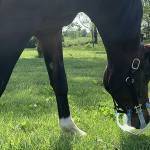Consider Strip Grazing for Metabolic Horses

Obesity is a risk factor for equine metabolic syndrome, hyperinsulinemia, and hyperinsulinemia-associated laminitis (HAL). Dietary management plays a key role in improving obesity and lowering circulating levels of insulin, which includes limiting pasture access. Strip grazing may be one way that owners decrease pasture intake while still allowing turnout time.
“Current dietary recommendations for managing horses with hyperinsulinemia include feeding hay with less than 10% nonstructural carbohydrates (NSC), eliminating pasture access, and avoiding grain in the diet. Pasture is not recommended because it can contain large concentrations of sugars, which may exacerbate insulin problems,” shared Ashley Fowler, Ph.D., a Kentucky Equine Research nutritionist.
Limiting a horse’s time on pasture has drawbacks, however.
“Horses are designed to continually consume forage. When pasture time is limited, horses must be provided with other forms of forage, such as hay,” said Fowler. “Many horses are only fed hay twice daily in ‘meals’ rather than having continuous access like when they’re on pasture.”
Two potential consequences of feeding meals include gastric ulcers and stereotypies.
“Providing hay in a drylot allows horses to exercise and socialize, but not all owners have access to a drylot. Fitting horses with grazing muzzles while they are on pasture is another option, but some horses are experts at removing them,” Fowler added.
Instead of completely taking horses off pasture, strip grazing might be a reasonable solution for decreasing pasture intake.
Strip grazing uses moveable fences to gradually give access to limited amounts of fresh herbage. A horse is turned out in one section and once that section is grazed down, the lead fence is moved forward to release a new section of ungrazed, mature pasture.
To better understand the “nutritive value” and digestibility of pastures, researchers collected and analyzed forage samples from grazed and ungrazed sections of strip grazing pastures. Based on those calculations, they suggested that strip grazing can be used for weight loss by adjusting the distance the lead fence is moved.
“This means that horses and ponies can lose weight and decrease their risk of developing hyperinsulinemia and laminitis while still having access to pasture,” Fowler said.
That said, there are some horses and ponies that should never have pasture access, such as those actively suffering a flare-up of laminitis. Further, strip grazing for weight-loss purposes can only be performed during summer months, after the rapid early spring growth period is over.
In their conclusion, the researchers of this study recommended a forage balancer “to mitigate against nutrient deficiencies that might occur, especially under conditions of restricted grazing.”
A low-intake concentrated source of vitamins and minerals ensures all nutrient requirements of mature horses and ponies are met.
*A.C. Longland, C. Barfoot, and P.A. Harris. 2023. Strip grazing: Changes in biomass, nutrient content and digestibility of temperate, midsummer pasture by strip-grazed or ‘free’-grazing ponies, over 4 weeks. Journal of Equine Veterinary Science 131:104957.








